Introduction: Capturing the Swedish Soul
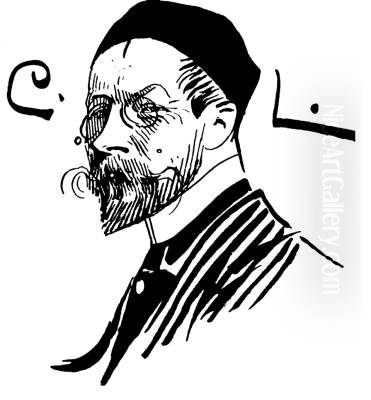
Carl Larsson (1853-1919) stands as one of Sweden's most beloved artists, a painter whose work has come to epitomize a certain idyllic vision of Swedish life. Working primarily during the late 19th and early 20th centuries, a period of significant national and artistic change, Larsson carved a unique niche for himself. While contemporaries explored dramatic landscapes, psychological portraits, or social realism of a grittier kind, Larsson turned his gaze inward, focusing on the intimate sphere of home and family. His light-filled watercolors, depicting his own bustling household in the Dalarna region, became incredibly popular, shaping not only artistic tastes but also ideals of interior design and family life that resonate even today. He was a master draftsman, a skilled illustrator, and a muralist of considerable ambition, creating a body of work that celebrates beauty in the everyday, infused with warmth, light, and a deep affection for his subjects.
A Difficult Start: Early Life in Stockholm
Carl Olof Larsson's beginnings were far removed from the sunlit domesticity he would later portray. Born in the Gamla Stan (Old Town) of Stockholm in 1853, his family lived in profound poverty. His father worked variously as a casual laborer and perhaps a granary worker, struggling with alcoholism and prone to fits of rage, casting a dark shadow over Carl's childhood. His mother, Johanna Carolina (née Ståhlberg), worked tirelessly as a laundress to support the family. Larsson later wrote about the misery and deprivation of these early years with bitterness, recalling the squalid conditions and emotional turmoil. This difficult upbringing arguably fueled his later desire to create a harmonious and loving environment for his own family, a sanctuary starkly contrasting with his own youth.
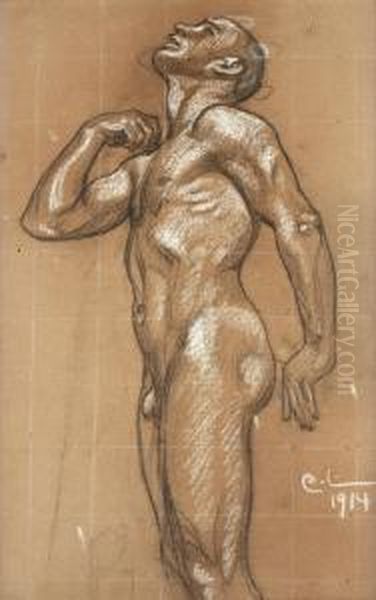
Despite the hardships, Larsson's artistic talent was undeniable even at a young age. A pivotal moment came when his teacher at the school for poor children, Jacobsen, recognized his potential and urged him to apply to the preparatory department of the Royal Swedish Academy of Arts (Konstakademien). At the age of thirteen, Larsson took this crucial step, entering a world vastly different from the one he knew. This was not just an opportunity for artistic training but a significant social leap, offering a path out of the poverty that had defined his early existence.
Academic Training and Early Promise
Larsson formally entered the Royal Swedish Academy of Arts in 1869, at the age of sixteen. The Academy, steeped in the traditions of classical art education, provided rigorous training in drawing, anatomy, and composition. Initially, Larsson felt socially insecure among his often wealthier classmates, but his talent soon earned him respect and recognition. He proved to be a brilliant student, excelling particularly in drawing. His skill was acknowledged when he received the Royal Medal for nude drawing in 1876, a significant honor within the Academy structure.
During his student years, Larsson needed to support himself financially. He began working as an illustrator and caricaturist, contributing drawings to humorous magazines like Kasper (starting around 1871) and newspapers such as Ny Illustrerad Tidning (from 1873). This early commercial work honed his skills in observation, narrative, and draftsmanship, providing practical experience alongside his formal academic studies. The need to produce work quickly and effectively for publication likely contributed to the clarity and fluency of line that would characterize his later style.
Finding a Foothold: Illustration and Early Works
Even after completing his studies at the Academy, Larsson initially struggled to establish himself as a serious painter. He continued to rely heavily on illustration work for income. Throughout the 1870s and early 1880s, he became a prolific and sought-after illustrator for books, journals, and newspapers. His work from this period often shows a historical or romantic inclination, sometimes executed with meticulous detail.
Notable commissions included illustrations for Zacharias Topelius's Fältskärns berättelser (Tales of a Barber-Surgeon), published 1883-1884, and Anna Maria Lenngren's Samlade Skrifter (Collected Writings), published in 1884. For the latter, he created watercolors in a delicate Rococo style, demonstrating his versatility and his ability to adapt his style to the subject matter. This period saw him developing technical proficiency, particularly in watercolor, a medium he would later master and make distinctively his own. His illustrations were popular and provided a steady income, but Larsson harbored ambitions beyond commercial art.
The Parisian Experience: Seeking New Horizons
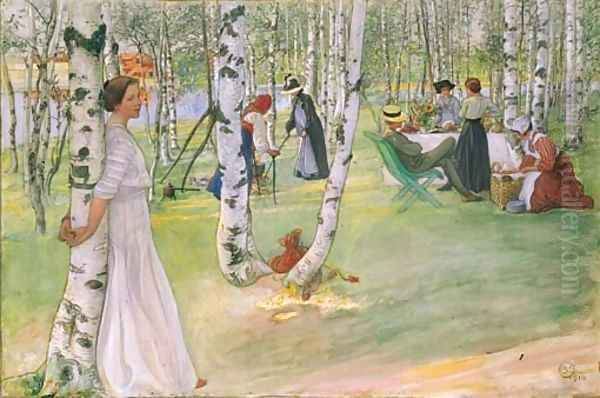
Like many aspiring artists of his generation, Carl Larsson felt the pull of Paris, the undisputed center of the art world in the late 19th century. He first traveled there in 1877, hoping to achieve success as a painter. However, his initial years in Paris were marked by frustration and lack of recognition. He attempted to paint large-scale historical or mythological subjects in the academic style favored by the official Salon, but these efforts met with little success. He felt alienated from the burgeoning Impressionist movement, led by artists like Claude Monet, Edgar Degas, and Pierre-Auguste Renoir, whose focus on capturing fleeting moments of light and color did not align with his own artistic temperament at the time.
A turning point came during his time spent outside Paris, particularly in the village of Grez-sur-Loing, an international artists' colony popular with Scandinavian, American, and British painters. Here, working outdoors (en plein air), Larsson began to shift away from dark studio palettes and historical themes towards a lighter, more naturalistic style, focusing on landscapes and scenes of everyday life. He was influenced by the French realist painter Jules Bastien-Lepage, whose detailed yet atmospheric depictions of rural life were admired by many artists in Grez. It was also in Grez-sur-Loing, in 1882, that he met the Swedish artist Karin Bergöö, a meeting that would profoundly change his life and art.
A Defining Partnership: Marriage to Karin Bergöö
Karin Bergöö (1859-1928) was herself a talented artist who had studied at the Academy in Stockholm and traveled to France to further her artistic development. She and Carl Larsson quickly formed a deep connection, sharing artistic sensibilities and a vision for life. They married in 1883 and initially remained in Grez, where Larsson produced some of his most acclaimed early watercolors, capturing the local landscape and village life with a newfound freshness and luminosity. These works began to attract positive attention and marked a significant shift in his artistic direction.
The marriage to Karin was arguably the most important event in Larsson's life. She became not only his wife and the mother of their eight children (seven of whom survived to adulthood: Suzanne, Ulf, Pontus, Lisbeth, Brita, Kersti, and Esbjörn) but also his closest artistic collaborator and muse. Karin largely gave up her own painting career after marriage, channeling her creative energies into designing textiles, furniture, clothing, and, most importantly, shaping the aesthetic of their home. Her artistic contributions were integral to the creation of the unique environment that would become the primary subject of Carl's most famous works.
Lilla Hyttnäs: The Birthplace of an Ideal
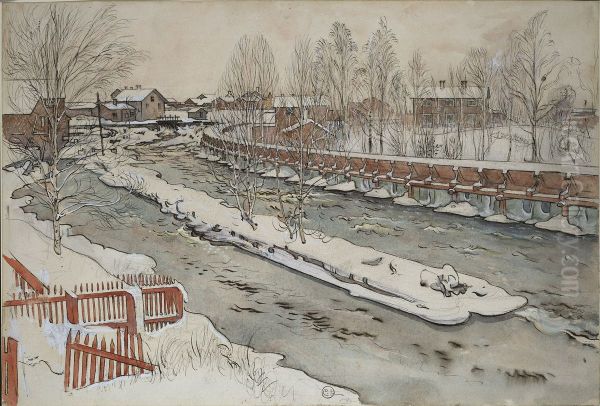
In 1888, Karin's father, Adolf Bergöö, gave the Larssons a small timber cottage named Lilla Hyttnäs, located in the village of Sundborn in the Dalarna province of Sweden. Initially intended as a summer retreat, Sundborn gradually became their permanent home and the center of their world. Over the years, Carl and Karin transformed the simple cottage into a vibrant, eclectic, and highly personal living space. They added extensions, painted furniture in bright colors, incorporated traditional Swedish folk art elements, and filled the rooms with Karin's handwoven textiles and Carl's paintings.
Lilla Hyttnäs became far more than just a house; it was a living work of art, a collaborative project reflecting the Larssons' aesthetic ideals and their vision of a happy, creative family life. It was here, amidst the cheerful clutter and bustling activity of their growing family, that Carl Larsson found his true artistic voice. The house and its inhabitants provided an endless source of inspiration, and he began meticulously documenting their daily lives in a series of intimate and joyful watercolors. This focus on their own domestic world became the hallmark of his mature style.
Crafting a World: The Sundborn Style
The interior design and overall aesthetic developed by Carl and Karin Larsson at Lilla Hyttnäs became immensely influential, often referred to as the "Sundborn Style." It represented a departure from the heavy, dark, and formal bourgeois interiors common at the time. Instead, the Larssons championed lightness, brightness, color, and functionality, blending traditional Swedish folk crafts with influences from the English Arts and Crafts movement (associated with figures like William Morris) and even Japanese aesthetics (visible in the use of asymmetry and bold outlines).
Key elements included painted wood furniture (often in reds, greens, and blues), exposed timber beams, floral patterns, Karin's innovative textiles (tapestries, rag rugs, tablecloths), and a general sense of comfortable, unpretentious domesticity. Carl's paintings, which depicted these interiors in loving detail, served to popularize this style. In 1899, he published a book titled Ett Hem (A Home), containing watercolors of Lilla Hyttnäs accompanied by his text. The book was an enormous success, translated into several languages, and played a significant role in promoting the Larssons' vision of modern, family-centered living. This aesthetic is often cited as an early precursor to the bright, functional design later popularized by companies like IKEA.
The Larsson Palette: Style, Technique, and Subject
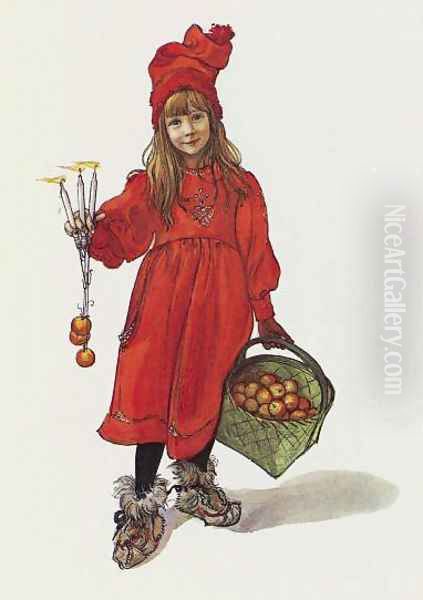
Carl Larsson's mature style is characterized by its clarity, brightness, and decorative quality. While he worked in oils, particularly for portraits and larger commissions, he is best known for his watercolors. He developed a distinctive watercolor technique, using clear, luminous colors often outlined with strong, fluid lines in ink or pencil. This emphasis on line perhaps stemmed from his background in illustration and gives his work a graphic sensibility, reminiscent in some ways of Japanese woodblock prints (Ukiyo-e), which were influential in Europe at the time (works by artists like Katsushika Hokusai and Utagawa Hiroshige were widely admired).
His subject matter centered overwhelmingly on his own family and home at Sundborn. He painted his children studying, playing, eating, sleeping, and engaging in various domestic chores and celebrations. He depicted the sun-drenched rooms of Lilla Hyttnäs, the blooming garden, the surrounding Dalarna landscape, and the changing seasons. His works exude a sense of warmth, intimacy, and contentment. While often idealized, his paintings are grounded in careful observation of everyday details – the pattern on a tablecloth, the way light falls on a wooden floor, a child's absorbed expression. This combination of realism and decorative idealization created a powerful and enduring appeal.
Iconic Visions: Key Works Explored
Beyond the general themes, several specific works and series stand out. The paintings collected in Ett Hem (1899) are perhaps the most iconic, including images like Mammas och småflickornas rum (Mummy's and the Little Girls' Room), Köket (The Kitchen), and Verandan (The Veranda). These watercolors established the visual language associated with Larsson: bright interiors, charming details, and affectionate portrayals of family life.
Other popular albums followed, including Spadarfvet, mitt lilla landtbruk (Spadarfvet, My Little Farm, 1906), depicting the family's engagement with agriculture, and Åt Solsidan (On the Sunny Side, 1910), which focused more on the garden and outdoor activities during summer. Individual paintings like Frukost i det gröna (Breakfast in the Open, often dated around 1896 but part of the Ett Hem series) or Kräftfångst (Crayfishing, 1897) capture specific moments of leisure and tradition. His numerous portraits of Karin and their children are also central to his oeuvre, showcasing his skill in capturing likeness and personality within his characteristic style.
Monumental Ambitions: The Midvinterblot Saga
While celebrated for his intimate domestic scenes, Carl Larsson also undertook large-scale public commissions, most notably frescoes for the Nationalmuseum (National Museum of Fine Arts) in Stockholm. He completed several frescoes depicting key moments in Swedish art history for the museum's stairwell walls between 1896 and 1908. However, his final, most ambitious project for the museum, Midvinterblot (Midwinter Sacrifice), became a source of prolonged controversy.
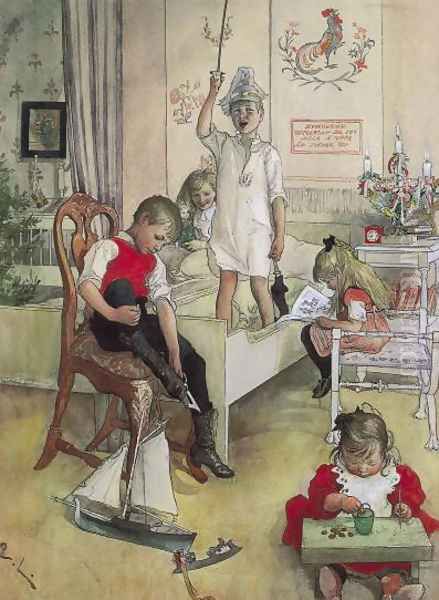
Intended for the last remaining wall space, the massive painting (approx. 6.5 x 13.5 meters) depicted a dramatic, imagined scene from Norse mythology: the pagan King Domalde being sacrificed to appease the gods during a famine. Larsson worked on the painting from 1911 to 1915. Its style was bolder, more stylized, and perhaps influenced by Art Nouveau and Symbolism, differing significantly from his earlier frescoes and his popular domestic watercolors. The museum committee ultimately rejected the painting in 1916, deeming it unsuitable and historically questionable.
The rejection was a bitter blow to Larsson, who considered Midvinterblot his masterpiece. He exhibited it elsewhere, but the controversy overshadowed his later years. The painting was eventually sold after his death and spent decades in storage or on loan, including a period in Japan. In a remarkable turn of events, the Nationalmuseum finally purchased Midvinterblot in 1997 for 14.6 million Swedish kronor (a record price for a Swedish painting at the time), and it now hangs in the location Larsson originally intended, recognized as a powerful, albeit contested, part of his legacy.
A Network of Artists: Friends, Rivals, and Patrons
Carl Larsson was an active figure in the Swedish art scene and maintained relationships with many prominent contemporaries, though these were not always smooth. His most famously complex relationship was with the brilliant but volatile writer and artist August Strindberg. Initially friends, their relationship soured, culminating in Strindberg publicly attacking Larsson and Karin in his polemical work En blå bok (A Blue Book), deeply wounding Larsson. Despite this, Larsson had previously painted a striking portrait of Strindberg, and evidence suggests Karin maintained a degree of respect for Strindberg's artistic genius.
Larsson enjoyed warmer friendships with other leading artists. He was close to Anders Zorn (1860-1920), another internationally renowned Swedish artist known for his virtuoso oil paintings and etchings, though their styles differed greatly. He was also friends with Bruno Liljefors (1860-1939), the preeminent painter of Swedish wildlife, although they reportedly grew apart later due to differing political views. Larsson was part of the "Opponenterna" (The Opponents), a group of artists who reacted against the conservative standards of the Royal Academy in the 1880s, which also included figures like Richard Bergh and Ernst Josephson.
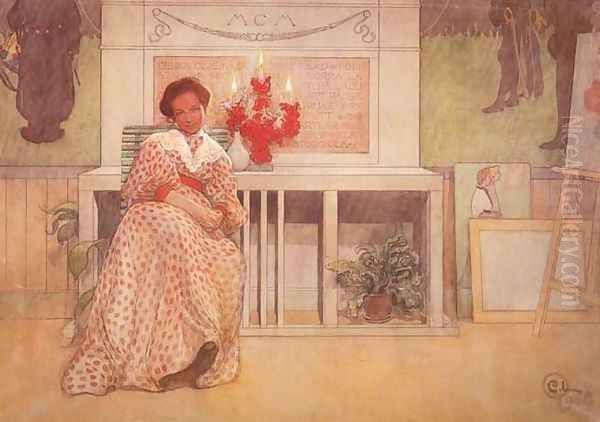
Patronage was crucial for Larsson, particularly for his larger projects. The Gothenburg merchant and art collector Pontus Fürstenberg was a significant early supporter, commissioning frescoes for his private residence. Larsson also enjoyed the support of figures like Prince Eugen (1865-1947), himself a notable landscape painter, and the publisher Thorsten Laurin. His interactions extended beyond Sweden; his work was admired by international figures like the American painter James Abbott McNeill Whistler and the French critic Théodore Duret. He was also aware of broader European trends, referencing artists like the Dutch master Johannes Vermeer and the French Rococo painter Jean-Baptiste van Loo in relation to his own stylistic interests. Connections also existed with German artists and educators like Georg Melchior Kraus. Prominent female artists like Eva Bonnier were also part of his milieu. His circle included other Swedish painters like Carl Wilhelmson, known for his depictions of coastal life.
Sharing the Vision: Teaching and Influence
Beyond his own artistic production, Carl Larsson also contributed to art education. From 1886 to 1888 and again from 1891 to 1893, he served as the director of the Valand Art School (Valands konstskola) in Gothenburg. During his tenure, he taught and mentored a generation of younger artists. His approach likely emphasized strong drawing skills and observation from life, reflecting his own artistic practice. He painted portraits of some of his students, integrating his teaching role into his artistic output.
His broader influence, however, stemmed less from direct teaching and more from the immense popularity of his published works depicting life at Sundborn. As mentioned earlier, Ett Hem and subsequent books had a profound impact on Swedish interior design and ideals of living. They promoted a vision of a bright, healthy, child-centered, and aesthetically pleasing home life that resonated with the burgeoning middle class and contributed to the development of what became known as Swedish Modern design. The Larsson home, Carl Larsson-gården, preserved as a museum, continues to attract visitors from around the world, testament to the enduring power of their shared vision.
Later Years and Enduring Legacy
Carl Larsson remained artistically active until the end of his life, although his final years were somewhat clouded by the Midvinterblot controversy and possibly declining health. He continued to paint portraits, illustrations, and scenes from Sundborn. He also wrote his autobiography, Jag (I), which was published posthumously in 1931, offering valuable, albeit subjective, insights into his life and thoughts. He passed away in Falun, near Sundborn, in January 1919.
His legacy is multifaceted. He is celebrated as a master watercolorist, a brilliant draftsman, and the creator of some of the most iconic images in Swedish art history. His depictions of family life at Lilla Hyttnäs have become synonymous with an idealized Swedish identity, representing harmony, closeness to nature, and domestic bliss. While some critics have pointed to the idealized, perhaps overly saccharine, nature of this vision, its appeal remains undeniable. His work captured a specific moment in Swedish cultural history, reflecting the values of National Romanticism while simultaneously promoting a modern, informal lifestyle.
Larsson in the Market
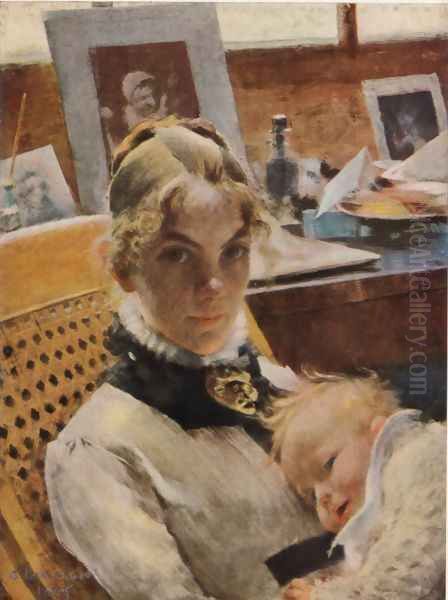
The enduring appeal of Carl Larsson's work is reflected in its continued strong performance in the art market. His paintings, particularly watercolors from his Sundborn period, are highly sought after by collectors both in Sweden and internationally. Auction results consistently demonstrate the value placed on his work. For instance, smaller works or studies can fetch significant prices, as seen with Gunlög reaching 20,000 SEK and Marstrand Garden Scene achieving the same price in recent auctions. More substantial or significant works command much higher figures, such as Kvinnofigur och himmel selling for 160,000 SEK in 2024.
The pinnacle of his market value, however, remains the aforementioned purchase of Midvinterblot by the Nationalmuseum for 14.6 million SEK in 1997, a testament to the cultural significance attributed to his major works. While representing a unique case due to its scale and history, it underscores the high regard in which Larsson is held. His works frequently appear in major Scandinavian art auctions, and pieces like Peek-A-Boo / Hide and seek continue to generate interest, ensuring his presence in the contemporary market.
Conclusion: An Enduring Vision
Carl Larsson occupies a unique and cherished place in the history of art. Emerging from poverty, he rose to become one of Sweden's most famous and influential artists. While engaged with the artistic currents of his time, he ultimately forged a deeply personal style centered on the joys and rhythms of his own family life. Through his luminous watercolors and popular illustrated books, he crafted an enduring vision of domestic harmony, artistic collaboration (with his wife Karin), and the beauty of everyday life in rural Sweden. His work celebrated light, color, and intimacy, offering an idealized yet relatable portrayal of home that continues to captivate and inspire audiences worldwide. From the intimate scenes at Lilla Hyttnäs to the monumental drama of Midvinterblot, Larsson's art provides a rich and varied window into the world of a remarkable Swedish painter.